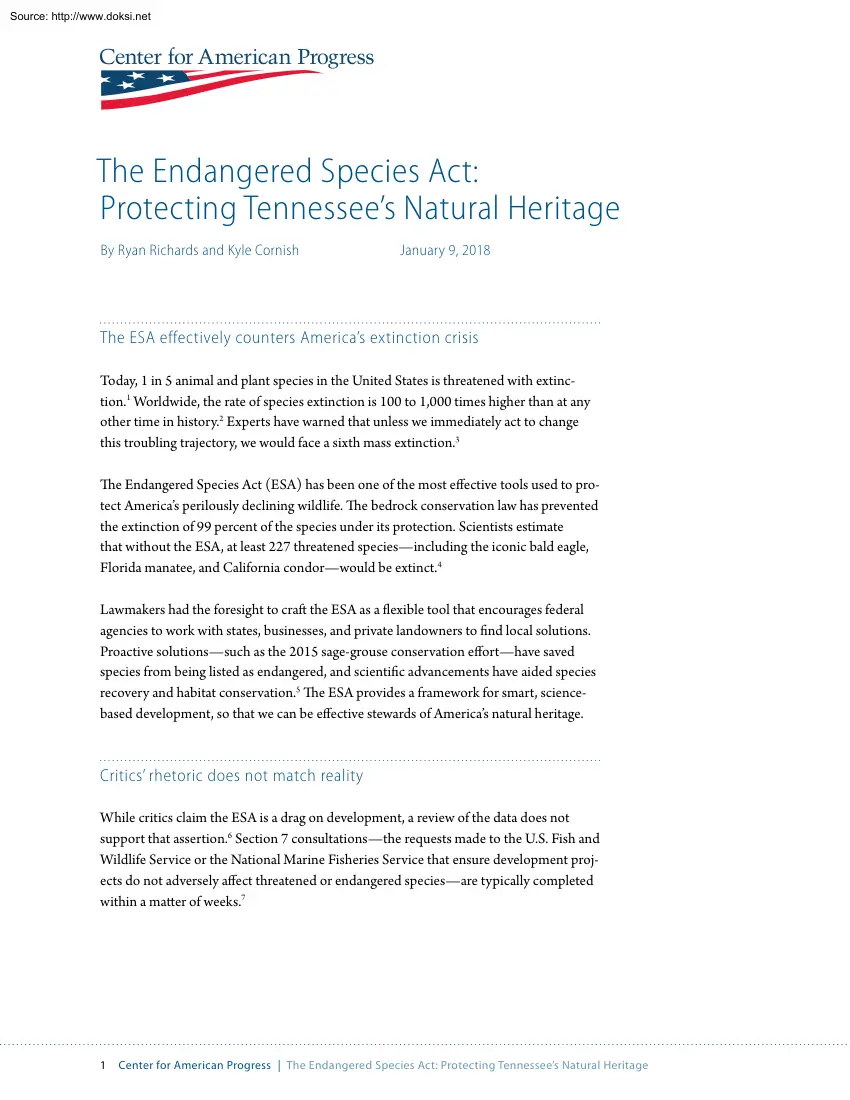Comments
No comments yet. You can be the first!
What did others read after this?
Content extract
Source: http://www.doksinet The Endangered Species Act: Protecting Tennessee’s Natural Heritage By Ryan Richards and Kyle Cornish January 9, 2018 The ESA effectively counters America’s extinction crisis Today, 1 in 5 animal and plant species in the United States is threatened with extinction.1 Worldwide, the rate of species extinction is 100 to 1,000 times higher than at any other time in history.2 Experts have warned that unless we immediately act to change this troubling trajectory, we would face a sixth mass extinction.3 The Endangered Species Act (ESA) has been one of the most effective tools used to protect America’s perilously declining wildlife. The bedrock conservation law has prevented the extinction of 99 percent of the species under its protection. Scientists estimate that without the ESA, at least 227 threatened speciesincluding the iconic bald eagle, Florida manatee, and California condorwould be extinct.4 Lawmakers had the foresight to craft the ESA as a
flexible tool that encourages federal agencies to work with states, businesses, and private landowners to find local solutions. Proactive solutionssuch as the 2015 sage-grouse conservation efforthave saved species from being listed as endangered, and scientific advancements have aided species recovery and habitat conservation.5 The ESA provides a framework for smart, sciencebased development, so that we can be effective stewards of America’s natural heritage Critics’ rhetoric does not match reality While critics claim the ESA is a drag on development, a review of the data does not support that assertion.6 Section 7 consultationsthe requests made to the US Fish and Wildlife Service or the National Marine Fisheries Service that ensure development projects do not adversely affect threatened or endangered speciesare typically completed within a matter of weeks.7 1 Center for American Progress | The Endangered Species Act: Protecting Tennessee’s Natural Heritage Source:
http://www.doksinet Between 2008 and 2015, nearly 110,000 requests for consultation were made on projects with the federal wildlife agencies. The median time for their approval was 14 business days.8 The 10 percent of requests requiring more formal consultation due to the projects’ likely impacts on ESA-listed species took 61 business daysfar from the gridlock some critics accuse the ESA of causing. During the same period, not one project was halted or significantly altered due to U.S Fish and Wildlife Service reviews9 The ESA is a proven conservation success Recovery of the Louisiana black bearwhich was delisted in 2015was the result of cooperation between wildlife agencies and private landowners to restore the species’ habitat in the bottomlands of the Mississippi Valley. Rewarding good stewardship, such as voluntary incentives to replant hardwood forests, resulted in quadrupled black bear population numbers over 10 years.10 TABLE 1 Consultations required under the Endangered
Species Act are typically approved within weeks Section 7 consultations with federal wildlife agencies in Tennessee, by project type Project type Total number of consultations Median days to approval, all consultations Number of formal consultations Median days to approval, formal consultations Agriculture 188 7.5 1 274 Forestry 68 11.5 1 82 Mining 83 1 2 62.5 Oil or gas 114 3 9 25 Oil or gas pipeline 3 28 0 N/A Transportation 445 5 6 36 All types 2,893 5 144 46 Source: Center for Conservation Innovation at the Defenders of Wildlife, “Endangered Species Act consultation explorer,” available at https://cci-dev.org/shiny/ open/section7 explorer/ (last accessed October 2017). ESA consultation processes are highly efficient Despite the rapid growth in demand for cellular data, ESA consultations to build cell towers have become efficient and quickmost consultations are completed in less than two weeks. The US Fish and Wildlife Service and the
Federal Communications Commission worked together to create a predictable, clear process that would work for everyone. 2 Center for American Progress | The Endangered Species Act: Protecting Tennessee’s Natural Heritage Source: http://www.doksinet Congress should fight for America’s wildlife Members of Congress who attack the ESA are out of step with core American values. Many Americans expect the government to act on their behalf as a responsible steward of wildlife and ecosystems. Numerous polls and focus groups have found that most Americansregardless of their political leaningsvalue the ESA’s role in protecting our wildlife and natural heritage and place the future of America’s wildlife high on their list of environmental concerns.11 Rather than rewriting the ESA on behalf of special interests, Congress should support the law and improve its implementation by fully funding recovery efforts for species at the brink of extinction. Ryan Richards is a senior policy analyst
for Public Lands at the Center for American Progress. Kyle Cornish is an intern for Energy and Environment at the Center. 3 Center for American Progress | The Endangered Species Act: Protecting Tennessee’s Natural Heritage Source: http://www.doksinet Endnotes 1 The International Union for Conservation of Nature, “The IUCN Red List of Threatened Species,” available at https:// www.iucnorg/theme/species/our-work/iucn-red-list-threatened-species (last accessed October 2017) 2 Stuart Pimm and others, “The biodiversity of species and their rates of extinction, distribution, and protection,” Science 344 (6187) (2014): 1246752, available at http://science. sciencemag.org/content/344/6187/1246752 3 Gerardo Ceballos, Paul Ehrlich, and Rodolfo Dirzo, “Biological annihilation via the ongoing sixth mass extinction signaled by vertebrate population losses and declines,” Proceedings of the National Academy of Sciences 114 (30) (2017): E6089-E6096, available at http://www.pnasorg/
content/114/30/E6089.full 4 Center for Biological Diversity, “The Endangered Species Act: A Wild Success,” available at http://www.biologicaldiversity org/campaigns/esa wild success/ (last accessed October 2017); Kieran Suckling, Noah Greenwald, and Tierra Curry, “On Time, On Target: How the Endangered Species Act is Saving America’s Wildlife” (Tucson, AZ: Center for Biological Diversity, 2012), available at http://www.esasuccessorg/ pdfs/110 REPORT.pdf 5 U.S Department of the Interior, “Historic Conservation Campaign Protects Greater Sage-Grouse,“ Press release, September 22, 2015, available at https://www.doigov/ pressreleases/historic-conservation-campaign-protectsgreater-sage-grouse. 4 6 Darryl Fears, “The Endangered Species Act may be heading for the threatened list. This hearing confirmed it,” The Washington Post, February 15, 2017, available at https:// www.washingtonpostcom/news/energy-environment/
wp/2017/02/15/the-endangered-species-act-may-beheading-for-the-threatened-list-this-hearing-confirmedit/?utm term=.d7d3579d33e3 7 The Center for Conservation Innovation, “Endangered Species Act consultation explorer,” available at https://cci-dev. org/shiny/open/section7 explorer/ (last accessed October 2017). 8 Ibid. 9 Ibid. 10 U.S Fish and Wildlife Service, “Louisiana black bear (Ursus americanus luteolus),” available at https://ecos.fwsgov/ ecp0/profile/speciesProfile?spcode=A08F (last accessed October 2017). 11 Western Watersheds Project, “New Polling Data Underscores Public Support for Endangered Species Protection,” The Wildlife News, January 18, 2017, available at http:// www.thewildlifenewscom/2017/01/18/new-polling-dataunderscores-public-support-for-endangered-speciesprotections/ Center for American Progress | The Endangered Species Act: Protecting Tennessee’s Natural Heritage
flexible tool that encourages federal agencies to work with states, businesses, and private landowners to find local solutions. Proactive solutionssuch as the 2015 sage-grouse conservation efforthave saved species from being listed as endangered, and scientific advancements have aided species recovery and habitat conservation.5 The ESA provides a framework for smart, sciencebased development, so that we can be effective stewards of America’s natural heritage Critics’ rhetoric does not match reality While critics claim the ESA is a drag on development, a review of the data does not support that assertion.6 Section 7 consultationsthe requests made to the US Fish and Wildlife Service or the National Marine Fisheries Service that ensure development projects do not adversely affect threatened or endangered speciesare typically completed within a matter of weeks.7 1 Center for American Progress | The Endangered Species Act: Protecting Tennessee’s Natural Heritage Source:
http://www.doksinet Between 2008 and 2015, nearly 110,000 requests for consultation were made on projects with the federal wildlife agencies. The median time for their approval was 14 business days.8 The 10 percent of requests requiring more formal consultation due to the projects’ likely impacts on ESA-listed species took 61 business daysfar from the gridlock some critics accuse the ESA of causing. During the same period, not one project was halted or significantly altered due to U.S Fish and Wildlife Service reviews9 The ESA is a proven conservation success Recovery of the Louisiana black bearwhich was delisted in 2015was the result of cooperation between wildlife agencies and private landowners to restore the species’ habitat in the bottomlands of the Mississippi Valley. Rewarding good stewardship, such as voluntary incentives to replant hardwood forests, resulted in quadrupled black bear population numbers over 10 years.10 TABLE 1 Consultations required under the Endangered
Species Act are typically approved within weeks Section 7 consultations with federal wildlife agencies in Tennessee, by project type Project type Total number of consultations Median days to approval, all consultations Number of formal consultations Median days to approval, formal consultations Agriculture 188 7.5 1 274 Forestry 68 11.5 1 82 Mining 83 1 2 62.5 Oil or gas 114 3 9 25 Oil or gas pipeline 3 28 0 N/A Transportation 445 5 6 36 All types 2,893 5 144 46 Source: Center for Conservation Innovation at the Defenders of Wildlife, “Endangered Species Act consultation explorer,” available at https://cci-dev.org/shiny/ open/section7 explorer/ (last accessed October 2017). ESA consultation processes are highly efficient Despite the rapid growth in demand for cellular data, ESA consultations to build cell towers have become efficient and quickmost consultations are completed in less than two weeks. The US Fish and Wildlife Service and the
Federal Communications Commission worked together to create a predictable, clear process that would work for everyone. 2 Center for American Progress | The Endangered Species Act: Protecting Tennessee’s Natural Heritage Source: http://www.doksinet Congress should fight for America’s wildlife Members of Congress who attack the ESA are out of step with core American values. Many Americans expect the government to act on their behalf as a responsible steward of wildlife and ecosystems. Numerous polls and focus groups have found that most Americansregardless of their political leaningsvalue the ESA’s role in protecting our wildlife and natural heritage and place the future of America’s wildlife high on their list of environmental concerns.11 Rather than rewriting the ESA on behalf of special interests, Congress should support the law and improve its implementation by fully funding recovery efforts for species at the brink of extinction. Ryan Richards is a senior policy analyst
for Public Lands at the Center for American Progress. Kyle Cornish is an intern for Energy and Environment at the Center. 3 Center for American Progress | The Endangered Species Act: Protecting Tennessee’s Natural Heritage Source: http://www.doksinet Endnotes 1 The International Union for Conservation of Nature, “The IUCN Red List of Threatened Species,” available at https:// www.iucnorg/theme/species/our-work/iucn-red-list-threatened-species (last accessed October 2017) 2 Stuart Pimm and others, “The biodiversity of species and their rates of extinction, distribution, and protection,” Science 344 (6187) (2014): 1246752, available at http://science. sciencemag.org/content/344/6187/1246752 3 Gerardo Ceballos, Paul Ehrlich, and Rodolfo Dirzo, “Biological annihilation via the ongoing sixth mass extinction signaled by vertebrate population losses and declines,” Proceedings of the National Academy of Sciences 114 (30) (2017): E6089-E6096, available at http://www.pnasorg/
content/114/30/E6089.full 4 Center for Biological Diversity, “The Endangered Species Act: A Wild Success,” available at http://www.biologicaldiversity org/campaigns/esa wild success/ (last accessed October 2017); Kieran Suckling, Noah Greenwald, and Tierra Curry, “On Time, On Target: How the Endangered Species Act is Saving America’s Wildlife” (Tucson, AZ: Center for Biological Diversity, 2012), available at http://www.esasuccessorg/ pdfs/110 REPORT.pdf 5 U.S Department of the Interior, “Historic Conservation Campaign Protects Greater Sage-Grouse,“ Press release, September 22, 2015, available at https://www.doigov/ pressreleases/historic-conservation-campaign-protectsgreater-sage-grouse. 4 6 Darryl Fears, “The Endangered Species Act may be heading for the threatened list. This hearing confirmed it,” The Washington Post, February 15, 2017, available at https:// www.washingtonpostcom/news/energy-environment/
wp/2017/02/15/the-endangered-species-act-may-beheading-for-the-threatened-list-this-hearing-confirmedit/?utm term=.d7d3579d33e3 7 The Center for Conservation Innovation, “Endangered Species Act consultation explorer,” available at https://cci-dev. org/shiny/open/section7 explorer/ (last accessed October 2017). 8 Ibid. 9 Ibid. 10 U.S Fish and Wildlife Service, “Louisiana black bear (Ursus americanus luteolus),” available at https://ecos.fwsgov/ ecp0/profile/speciesProfile?spcode=A08F (last accessed October 2017). 11 Western Watersheds Project, “New Polling Data Underscores Public Support for Endangered Species Protection,” The Wildlife News, January 18, 2017, available at http:// www.thewildlifenewscom/2017/01/18/new-polling-dataunderscores-public-support-for-endangered-speciesprotections/ Center for American Progress | The Endangered Species Act: Protecting Tennessee’s Natural Heritage





